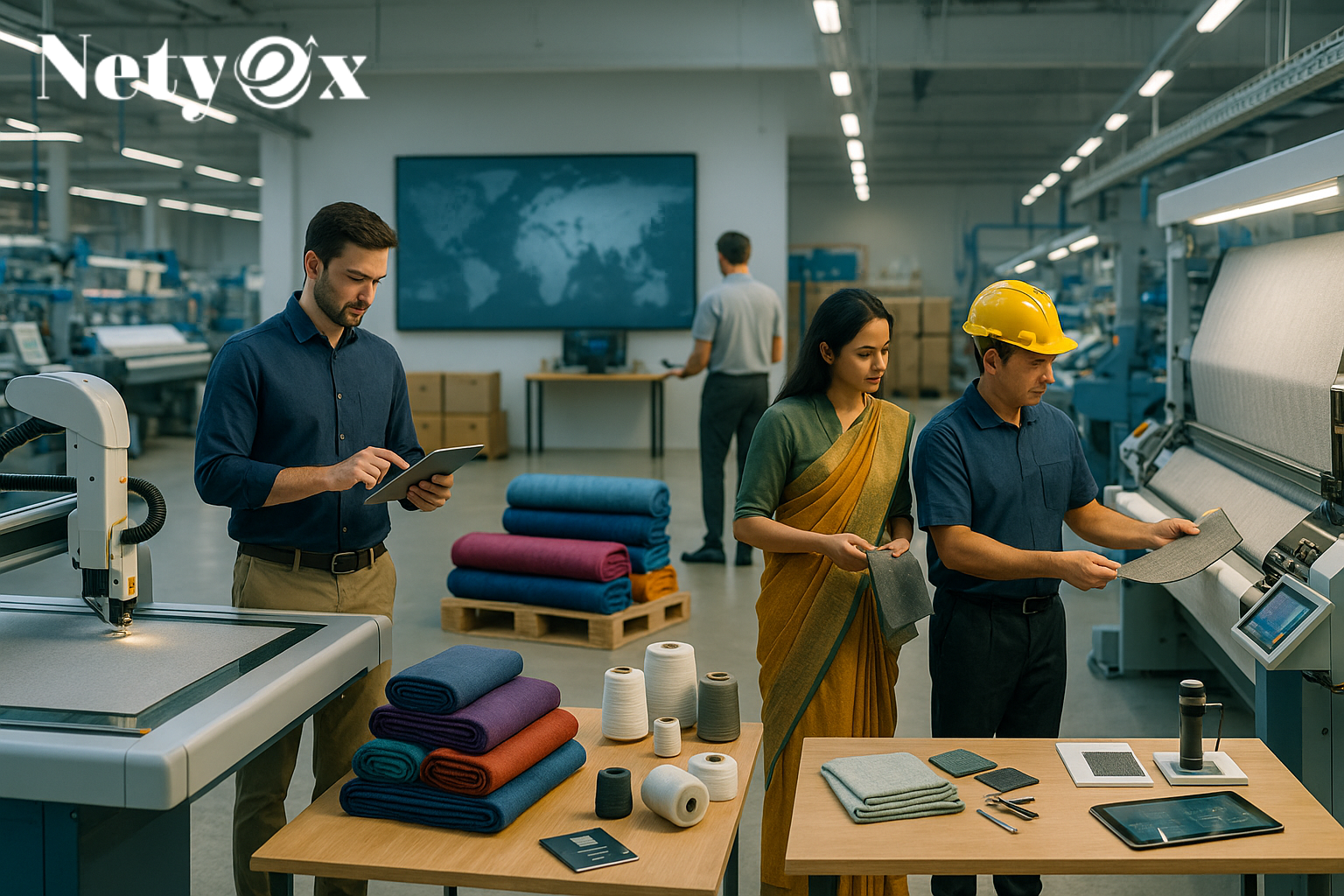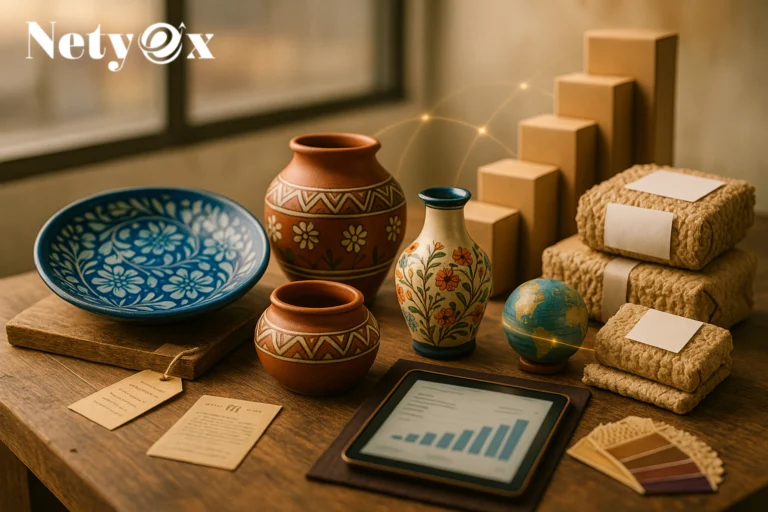Introduction to Technology in Textile Manufacturing
The textile industry has always been at the heart of innovation, shaping civilizations and economies for centuries. Today, as technology continues to advance at lightning speed, modern textile manufacturing has undergone a revolutionary transformation. From weaving machines powered by artificial intelligence to eco-friendly dyeing methods that save billions of liters of water, technology is reshaping every corner of the industry.
This evolution is not just about producing fabrics faster; it’s about creating sustainable, efficient, and customer-focused solutions that align with the demands of the 21st century. The role of technology in modern textile manufacturing has become more critical than ever, blending tradition with cutting-edge innovation.
Historical Perspective: From Handlooms to Smart Factories
The Era of Manual Weaving and Early Machinery
Textile production dates back thousands of years, beginning with simple handlooms and natural fibers. In these early stages, craftsmanship was the cornerstone of textile creation. Fabrics were produced slowly, and each piece reflected the skill of the artisan.
The Industrial Revolution and Mechanized Looms
The 18th and 19th centuries ushered in the industrial revolution, transforming the textile industry into one of the first to adopt large-scale mechanization. The invention of spinning jennies, power looms, and steam-powered machinery drastically increased production capacity and reduced human labor dependency.
Digital Transformation in Textiles
Fast forward to the 20th and 21st centuries, the industry saw the rise of digital tools such as computer-aided design (CAD), enabling designers to create patterns virtually. Today’s smart factories integrate robotics, IoT, and artificial intelligence, creating a new era of connected, intelligent manufacturing.
Key Technologies Shaping Textile Manufacturing Today
Automation and Robotics in Textile Production
Robotics have streamlined repetitive tasks like cutting, sewing, and packaging, minimizing errors and improving efficiency. Automated systems reduce costs and ensure consistent quality, especially in large-scale textile mills.
Computer-Aided Design (CAD) and Digital Pattern Making
Gone are the days of hand-drawn sketches. With CAD software, textile designers can create and modify intricate patterns with ease. This technology reduces material waste and speeds up the prototyping process.
Artificial Intelligence and Machine Learning in Quality Control
AI-powered systems use image recognition to detect defects such as fabric tears or irregular patterns. Machine learning algorithms improve accuracy over time, reducing waste and maintaining high product standards.
3D Printing and Rapid Prototyping in Textiles
3D printing is making waves in textile prototyping, allowing manufacturers to experiment with innovative materials and designs. Designers can produce fabric samples quickly, testing durability and aesthetics before mass production.
Internet of Things (IoT) in Smart Textile Factories
IoT-enabled devices monitor machinery performance, track fabric quality, and optimize production lines in real time. This connectivity ensures minimal downtime and helps manufacturers meet tight deadlines.
Role of Sustainable Technologies in the Textile Industry
Waterless Dyeing Techniques
Traditional dyeing consumes massive amounts of water, but new technologies like supercritical CO₂ dyeing have reduced this usage significantly, saving resources and cutting pollution.
Energy-Efficient Machinery
Modern spinning and weaving machines are designed to consume less power while maintaining output, reducing the carbon footprint of textile factories.
Eco-Friendly Fibers and Biodegradable Materials
The use of organic cotton, hemp, bamboo, and lab-grown fibers is rising. These materials not only appeal to eco-conscious consumers but also align with global sustainability goals.
Waste Reduction and Circular Economy Models
Recycling textile waste into new fabrics is gaining traction. Brands are embracing circular models where old garments are reintroduced into the production cycle, reducing landfill waste.
Enhancing Productivity and Efficiency Through Technology
Real-Time Monitoring Systems
Modern textile factories rely on real-time monitoring tools to track production lines and machine health. With sensors embedded in equipment, supervisors can instantly detect bottlenecks or inefficiencies. This real-time data helps reduce downtime, improve quality, and increase overall factory productivity.
Predictive Maintenance of Textile Machinery
Instead of waiting for machinery to break down, predictive maintenance uses AI-driven analytics to forecast when equipment is likely to fail. This proactive approach minimizes costly repairs, prevents production delays, and extends the lifespan of textile machinery.
Streamlining Supply Chain and Logistics with Technology
Digital platforms have optimized textile supply chains by offering end-to-end visibility. Manufacturers can track raw material shipments, monitor warehouse inventories, and manage distribution efficiently. Blockchain technology is also being explored to enhance transparency and traceability in the textile supply chain.
Impact of Technology on Workforce and Skills
Changing Roles of Textile Workers
As automation and robotics handle repetitive tasks, human roles are shifting towards technical supervision, innovation, and management. Workers now play a crucial role in overseeing automated processes and ensuring quality standards are maintained.
Upskilling and Reskilling for Digital Tools
To remain competitive, textile workers are encouraged to learn digital design, data analysis, and machinery programming. Governments and companies are investing in training programs to bridge the skill gap in the evolving industry.
Human-Machine Collaboration in Textile Factories
Technology hasn’t replaced people entirely; instead, it has fostered collaboration. In modern textile factories, human creativity works alongside machines, combining automation’s efficiency with human intuition to deliver innovative textile solutions.
Customer-Centric Innovations Enabled by Technology
Personalized Fashion Through Digital Design
Digital platforms allow customers to customize clothing designs online, which are then manufactured using CAD and automated cutting machines. This personalization trend gives consumers more control over style and fit.
Smart Fabrics and Wearable Textiles
The rise of smart textiles has introduced fabrics embedded with sensors, conductive yarns, and nanotechnology. These innovative materials are used in sportswear, healthcare garments, and military uniforms to monitor body performance and environmental conditions.
Virtual Try-On Solutions and Augmented Reality in Fashion
Augmented reality (AR) tools let customers virtually “try on” clothes before purchase. This innovation reduces return rates, improves customer satisfaction, and helps fashion retailers stand out in a competitive market.
Challenges of Implementing Technology in Textile Manufacturing
High Initial Investment Costs
While advanced technologies improve efficiency, the upfront investment is often a barrier for small and medium-sized enterprises. High-tech machinery and software require substantial financial resources.
Cybersecurity and Data Protection in Smart Factories
As factories adopt IoT and digital tools, they face increased risks of cyberattacks. Protecting sensitive production data and supply chain information has become a top priority for manufacturers.
Resistance to Change in Traditional Textile Hubs
In many regions, textile businesses rely on traditional practices. Shifting to modern technology requires cultural change, training, and acceptance, which can slow down adoption.
Case Studies: Technology Transformations in Textile Companies
Leading Global Innovators in Textile Tech
Companies like Adidas and Nike have adopted 3D knitting technology and smart production lines to reduce waste and speed up delivery. These global giants set the benchmark for digital textile innovation.
Success Stories from Sustainable Textile Brands
Brands such as Patagonia and Levi’s are integrating sustainable practices like waterless dyeing and recycling old garments. Their success demonstrates how technology can align profitability with eco-friendly values.
Future Trends in Textile Manufacturing Technology
Integration of Blockchain for Transparency
Blockchain technology is expected to play a big role in ensuring supply chain transparency, allowing consumers to track the origin and sustainability of their garments.
Nanotechnology and Advanced Fabric Engineering
Nanotechnology is opening doors for fabrics that are water-repellent, antibacterial, and UV-protective. These advanced textiles will revolutionize industries from sportswear to healthcare.
AI-Driven Fully Automated Textile Factories
The future may see lights-out factories—textile plants run entirely by AI-driven machines with minimal human intervention. This shift will drastically improve efficiency while lowering costs.
FAQs on Technology in Textile Manufacturing
1. How has technology improved textile manufacturing efficiency?
Technology has introduced automation, AI, and IoT systems that reduce errors, improve speed, and enhance quality control, making production more efficient.
2. What role does CAD play in textile design?
CAD software allows designers to create precise digital patterns, reducing waste and speeding up the prototyping process.
3. How does technology support sustainability in textiles?
Technologies such as waterless dyeing, eco-friendly fibers, and recycling initiatives reduce environmental impact and promote sustainable practices.
4. Are textile workers losing jobs to automation?
Automation has changed roles rather than eliminated them. Workers are shifting to more skilled tasks, focusing on operating and maintaining advanced technologies.
5. What are smart textiles?
Smart textiles are fabrics embedded with sensors or nanotechnology, capable of responding to environmental conditions or tracking biometric data.
6. What challenges do companies face in adopting textile technologies?
The main challenges include high initial costs, cybersecurity concerns, and resistance to change within traditional manufacturing hubs.
Conclusion: The Future of Tech-Driven Textile Industry
The role of technology in modern textile manufacturing is undeniable—it has redefined efficiency, sustainability, and innovation. From automation and AI to eco-friendly materials and smart fabrics, technological advancements are shaping a future where textiles are not just functional but also intelligent, sustainable, and personalized.
While challenges like cost and resistance to change remain, the benefits far outweigh the obstacles. The textile industry is no longer just about weaving threads; it’s about weaving together technology, creativity, and sustainability to build a smarter and more responsible future.













